Five things to know about… the L&B Room
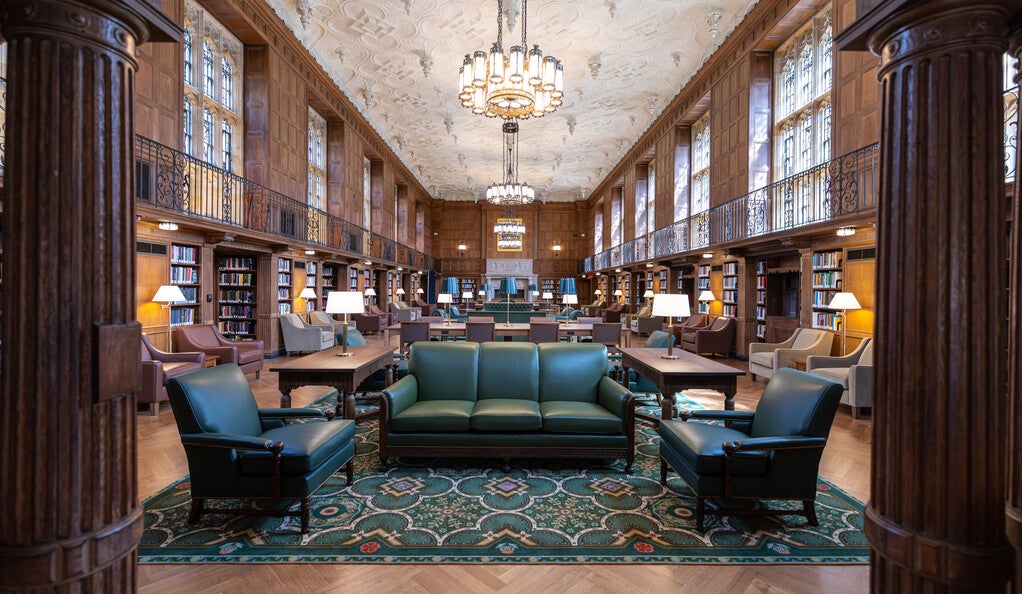
Sterling Memorial Library’s beloved L&B Room has reopened this week following a floor-to-ceiling renovation. (Photos by Dan Renzetti)
When architect James Gamble Rogers, a member of Yale’s Class of 1889, designed Sterling Memorial Library in the late-1920s, he envisioned the Linonia and Brothers (L&B) Room as a sanctuary where students could relax and read for pleasure. And that’s how generations of alumni have treated the room and its six alcoves, curling up in its green armchairs with a book.
A floor-to-ceiling renovation has restored the L&B Room to its original luster and updated it for a new generation of students seeking peace and quiet. It reopens to students on Monday, April 15.
The renovation, managed by Yale’s Office of Facilities in collaboration with New Haven-based Apicella + Bunton Architects, included the installation of a new HVAC system, which brought much-needed ventilation and climate control to a space notorious for being stuffy in the winter and sultry in the summer. Non-original paneling was removed from the double colonnade at the room’s entrance, opening its three archways and allowing more natural light into the space. The space adjoining the archways has become the Berg Family Foyer. Its built-in shelves will house a collection of books about Yale and New Haven history.
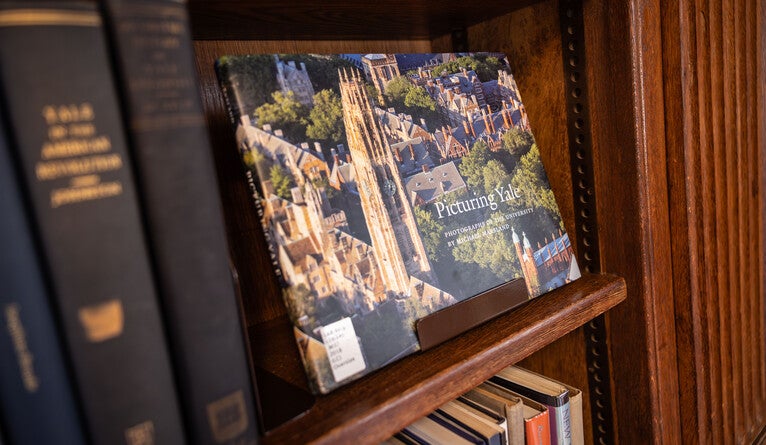
Yale News recently toured the renovated room with two members of the project team from the Office of Facilities: James Fullton III, an architect and planner, and Sydney Colon, the construction project manager. Here’s five things to know about the renewed L&B Room:
The room features an artifact of the library’s high-tech past.
Designed by Rogers in the collegiate gothic style, the library resembles a European cathedral from the Middle Ages, but from its beginnings it has contained some high-tech flourishes. When the building opened in 1931, its limestone and sandstone walls concealed a state-of-the-art pneumatic-tube system for exchanging messages. Stations were located at the front desk, in reading rooms and offices, and throughout the stacks. Patrons used the system to request books from the stacks, which were generally closed to students and faculty.
One of the tube stations has been restored and returned to its original spot in the L&B Room. The station, a wooden cabinet that conceals metal tubes for incoming and outgoing messages, had been in storage for years. The system, now inoperable, connected to the station through the floor.
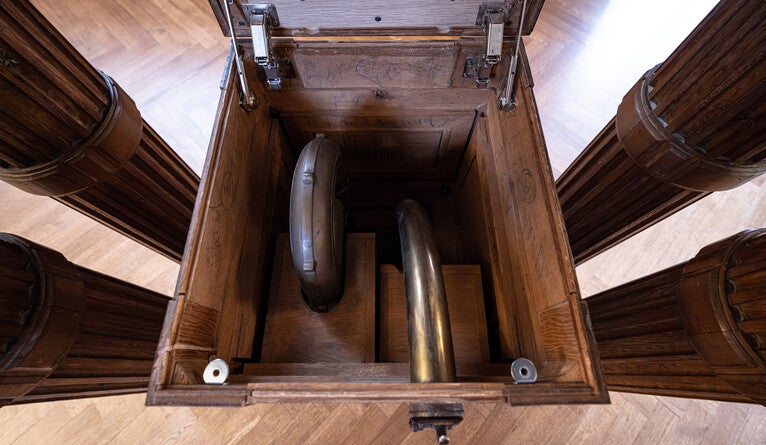
The green chairs and divans are original to the space.
The room’s green upholstered couches and armchairs are an important part of its cozy charm. The project restored the traditional green upholstery of pieces original to the room and supplemented them with new armchairs, upholstered in brown and tan, that line the space’s perimeter. The four chairs in the foyer are original, but they were upholstered in brown leather to help set off the space from the rest of the room, Fullton said.
The team studied archival photos, consulted with John Stuart Gordon, the Benjamin Attmore Hewitt Curator of American Decorative Arts at the Yale University Art Gallery, and worked with Benny Becker, a skilled craftsman at Norton Upholstery in West Haven, Connecticut, to restore the original chairs and couches. Some are upholstered in leather, others fabric. (The chairs and couches had been reupholstered over the years and, before the renovation, most were vinyl.) They come in two shades: the couches are “Pine,” and the chairs are “Holiday.”
“One of the beauties of this space, and how it was described historically in the Library Gazette, is that it feels like a grand living room,” Fullton said. “And living rooms are not usually furnished entirely with matching pieces. You may have things that go together, but they don’t precisely match. That’s what we were going for here.”
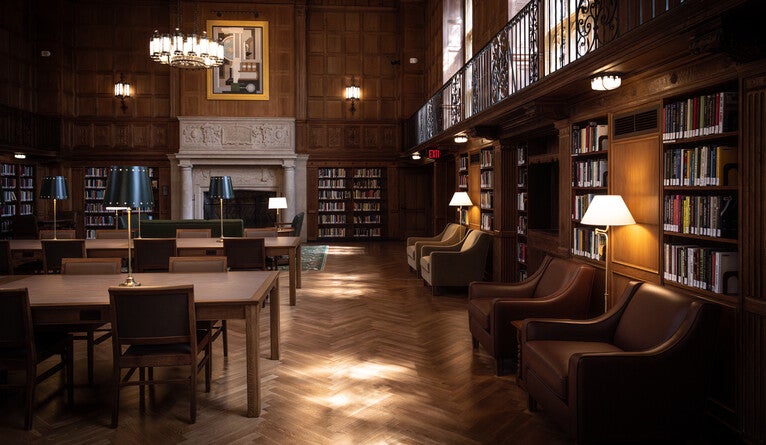
Cleaning the ceiling took painstaking effort.
Workers on scaffolds cleaned the room’s ornamental white ceiling by hand using cloths and brushes, but no soaps or solvents. A wet cleaning method was originally planned but early in the process, workers noticed the wet cloths were removing original paint and switched to dry-cleaning the ceiling, Colon said. The task, which took about a month to complete, cleared away decades’ worth of grime, leaving the ceiling and room much brighter. The ceilings in the foyer and alcoves, which are significantly lower than in the main space, were repainted to match their original white.
The room’s light fixtures, including four original chandeliers, were refinished and outfitted with more efficient LED lights. The chandeliers, originally produced by Edward F. Caldwell & Co., a premier manufacturer of light fixtures in the early- to mid-20th century, were removed and transported to Grand Light, a company based in Seymour, Connecticut, where they were cleaned and rewired. They received a wax finish for protection, as they would have had when brand-new, Gordon said.
New upward-facing lighting fixtures discreetly installed in the chandeliers and at the mezzanine level highlight the ceiling’s detail and add ambient light to the space.
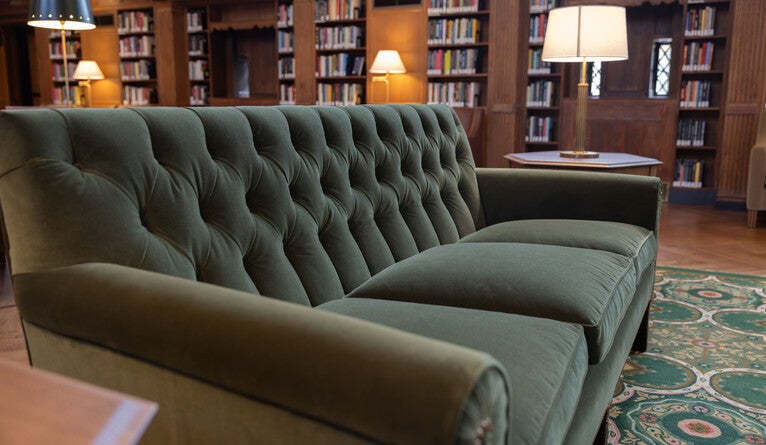
The wall-to-wall green carpet is gone.
For decades, green carpeting concealed the room’s original hardwood floor — a mixture of oak and tropical hardwoods. The carpet was removed but it had stuck to the floor in places, and there was water damage, which made the original floor unsalvageable. The new herringbone floor of sustainably harvested white oak recreates the original pattern as closely as possible, Fullton said. Custom-designed rugs — one in the foyer, three in the main space, and one in each of the alcoves — bear patterns drawn from the ornamentation on the room’s ceiling. Those in the main space are largely colored in shades of green, while the rug in the foyer has blue and green elements. The alcove rugs are green and beige. Their designs include decorative motifs from other places in the library. For instance, a sundial element is inspired by a sundial carved above the Selin courtyard door to the university librarian’s office.
“We wanted to pull together different decorative components from throughout the building in interesting ways,” Fullton said.

The room’s stone fireplace is decorated with fossils.
A thorough cleaning exposed patterns and ornamentation in the fireplace’s stone and brick that weren’t visible before the renovation, including genuine fossil shells embedded into the stone.
The fireplace’s original metalwork — its grate, andirons, brush, and poker — are stamped with the name of the maker, Samuel Yellin, a master blacksmith and metal designer who operated out of Philadelphia. Yellin produced metalwork for libraries, museums, banks, and academic and commercial buildings throughout the country through the 1930s. (He designed decorative metalwork throughout Yale’s campus, including the Memorial Quadrangle Gateway at Branford College, the Grand Exhibition Room Gates at Sterling Memorial Library, and the Humanities Quadrangle Gateway.)
A reproduction of “Bibliothèque (Library),” a 1926 oil painting by artist Gerald Murphy, a 1912 graduate of Yale College, now graces the wall above the fireplace. The reproduction — the original is in the collection of the Yale University Art Gallery but not on view — incorporates references to the artist’s father’s personal library. Murphy and his wife, Sara, inspired the protagonists Dick and Nicole Diver in F. Scott Fitzgerald’s “Tender is the Night.” Their papers are held by the Beinecke Rare Book and Manuscript Library.
Media Contact
Allison Bensinger: allison.bensinger@yale.edu,